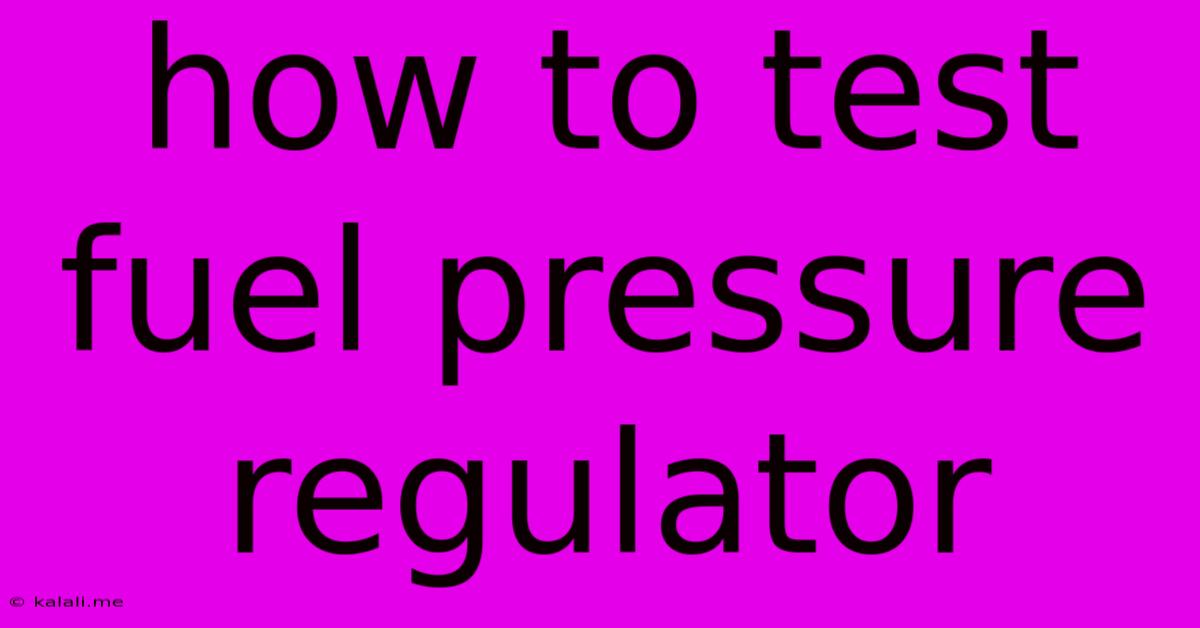How To Test Fuel Pressure Regulator
Kalali
May 28, 2025 · 4 min read

Table of Contents
How to Test a Fuel Pressure Regulator: A Comprehensive Guide
Meta Description: Learn how to test your fuel pressure regulator effectively, saving you time and money on potential repairs. This guide covers visual inspection, pressure testing methods, and interpreting the results. Avoid costly mistakes with our step-by-step instructions.
A malfunctioning fuel pressure regulator (FPR) can significantly impact your vehicle's performance, leading to poor fuel economy, rough idling, and even engine stalling. Knowing how to test your fuel pressure regulator is a valuable skill for any car owner, potentially saving you substantial repair costs. This guide provides a step-by-step approach to diagnosing a faulty FPR, covering both visual inspection and pressure testing.
Understanding the Fuel Pressure Regulator's Role
Before diving into the testing process, let's briefly understand the FPR's function. The fuel pressure regulator maintains consistent fuel pressure within the fuel rail. It does this by regulating the amount of fuel returning to the fuel tank. If the regulator fails, it can either maintain pressure too high (over-pressurizing the system) or too low (leading to insufficient fuel delivery).
Visual Inspection: The First Step
Before embarking on more complex tests, a simple visual inspection can often reveal obvious problems.
- Check for Leaks: Carefully examine the FPR for any signs of fuel leaks. Look for wetness or fuel residue around the regulator itself and its connections. Leaks indicate a potential problem requiring immediate attention.
- Inspect the Vacuum Line: The FPR is usually connected to the intake manifold via a vacuum line. Check this line for cracks, kinks, or disconnections. A damaged vacuum line will affect the regulator's ability to function correctly.
- Look for Physical Damage: Examine the FPR for any physical damage, such as cracks or dents. Any visible damage suggests the regulator may be compromised.
If you spot any of these issues during your visual inspection, it's highly likely the FPR needs replacement.
Pressure Testing: The Definitive Test
Visual inspection provides clues, but pressure testing offers definitive results. This will require specialized tools.
Tools You'll Need:
- Fuel Pressure Gauge: This is essential for accurately measuring fuel pressure.
- Fuel Pressure Test Kit: This kit typically includes the gauge, hoses, and adapters to connect to your vehicle's fuel system.
- Shop Rags: For cleaning up any spilled fuel.
- Safety Glasses: To protect your eyes from potential fuel spray.
- Gloves: To prevent fuel from contacting your skin.
Steps for Pressure Testing:
- Safety First: Disconnect the negative battery terminal before starting any work on the fuel system.
- Locate the Fuel Pressure Test Port: This port is usually located on the fuel rail. Consult your vehicle's repair manual to identify its exact location.
- Connect the Test Kit: Carefully connect the fuel pressure gauge to the test port using the appropriate adapters.
- Start the Engine: Turn the ignition key to the "on" position without starting the engine. This will prime the fuel pump and build up pressure.
- Start and Observe: Start the engine and monitor the fuel pressure gauge. The specified pressure should be listed in your vehicle's repair manual.
- Check for Pressure Holding: After the engine has been running for a few minutes, turn it off and note how quickly the pressure drops. A significant drop indicates a faulty FPR or other issues within the fuel system.
- Disconnect and Reconnect: Disconnect and reconnect the fuel pressure test kit multiple times to ensure you are getting accurate pressure readings.
Interpreting the Results
- Pressure Too High: If the fuel pressure is consistently higher than specified, the FPR may be malfunctioning and not regulating pressure effectively.
- Pressure Too Low: Low fuel pressure suggests the FPR might be leaking or failing to maintain adequate pressure.
- Pressure Dropping Too Quickly: A rapid pressure drop after turning off the engine strongly suggests a faulty FPR or a leak within the fuel system.
Conclusion
Testing your fuel pressure regulator doesn't require advanced mechanical skills, but it does require precision and safety precautions. By following these steps and carefully interpreting the results, you can determine if your FPR is the source of your vehicle's performance problems, saving yourself time and potentially significant repair costs. Remember to always consult your vehicle's repair manual for specific pressure specifications and locations of components.
Latest Posts
Latest Posts
-
How Do I Turn Off Talkback
May 29, 2025
-
How To Write Pounds And Ounces
May 29, 2025
-
It Would Be Great If You Could Kindly
May 29, 2025
-
Should I Conduct Eda Or Business Logic First Data Analysis
May 29, 2025
-
Wiring A Ceiling Fan With Light
May 29, 2025
Related Post
Thank you for visiting our website which covers about How To Test Fuel Pressure Regulator . We hope the information provided has been useful to you. Feel free to contact us if you have any questions or need further assistance. See you next time and don't miss to bookmark.